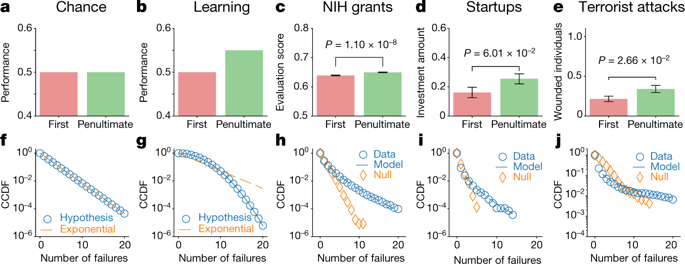Our official English website, www.x-mol.net, welcomes your
feedback! (Note: you will need to create a separate account there.)
Quantifying the dynamics of failure across science, startups and security
Nature ( IF 50.5 ) Pub Date : 2019-10-30 , DOI: 10.1038/s41586-019-1725-y Yian Yin 1, 2, 3 , Yang Wang 1, 2, 4 , James A Evans 5, 6 , Dashun Wang 1, 2, 3, 4
Nature ( IF 50.5 ) Pub Date : 2019-10-30 , DOI: 10.1038/s41586-019-1725-y Yian Yin 1, 2, 3 , Yang Wang 1, 2, 4 , James A Evans 5, 6 , Dashun Wang 1, 2, 3, 4
Affiliation

|
Human achievements are often preceded by repeated attempts that fail, but little is known about the mechanisms that govern the dynamics of failure. Here, building on previous research relating to innovation1–7, human dynamics8–11 and learning12–17, we develop a simple one-parameter model that mimics how successful future attempts build on past efforts. Solving this model analytically suggests that a phase transition separates the dynamics of failure into regions of progression or stagnation and predicts that, near the critical threshold, agents who share similar characteristics and learning strategies may experience fundamentally different outcomes following failures. Above the critical point, agents exploit incremental refinements to systematically advance towards success, whereas below it, they explore disjoint opportunities without a pattern of improvement. The model makes several empirically testable predictions, demonstrating that those who eventually succeed and those who do not may initially appear similar, but can be characterized by fundamentally distinct failure dynamics in terms of the efficiency and quality associated with each subsequent attempt. We collected large-scale data from three disparate domains and traced repeated attempts by investigators to obtain National Institutes of Health (NIH) grants to fund their research, innovators to successfully exit their startup ventures, and terrorist organizations to claim casualties in violent attacks. We find broadly consistent empirical support across all three domains, which systematically verifies each prediction of our model. Together, our findings unveil detectable yet previously unknown early signals that enable us to identify failure dynamics that will lead to ultimate success or failure. Given the ubiquitous nature of failure and the paucity of quantitative approaches to understand it, these results represent an initial step towards the deeper understanding of the complex dynamics underlying failure.A model demonstrates that people who eventually succeed and those who do not may initially appear similar, but are characterized by fundamentally distinct failure dynamics in terms of the efficiency and quality of each subsequent attempt to succeed.
中文翻译:

量化科学、初创企业和安全领域的失败动态
人类取得成就之前往往是反复尝试失败,但人们对控制失败动态的机制知之甚少。在这里,基于先前与创新 1-7、人类动力学 8-11 和学习 12-17 相关的研究,我们开发了一个简单的单参数模型,模拟未来尝试如何成功建立在过去的努力之上。分析地解决这个模型表明,相变将失败的动态分为进展或停滞的区域,并预测在临界阈值附近,具有相似特征和学习策略的代理可能会在失败后经历根本不同的结果。在临界点之上,代理利用渐进式改进系统地向成功迈进,而在临界点之下,他们在没有改进模式的情况下探索不相交的机会。该模型做出了几个可凭经验检验的预测,表明最终成功的人和不成功的人最初可能看起来相似,但在与每次后续尝试相关的效率和质量方面,其特征可以是根本不同的失败动态。我们从三个不同的领域收集了大规模数据,并追踪了调查人员多次尝试获得美国国立卫生研究院 (NIH) 资助以资助他们的研究、创新者成功退出其初创企业以及恐怖组织声称在暴力袭击中造成人员伤亡。我们在所有三个领域都找到了广泛一致的经验支持,这系统地验证了我们模型的每个预测。一起,我们的发现揭示了可检测但以前未知的早期信号,使我们能够识别导致最终成功或失败的失败动态。鉴于失败无处不在的性质以及理解失败的定量方法的缺乏,这些结果代表了朝着更深入理解失败背后的复杂动态的第一步。一个模型表明,最终成功的人和没有成功的人最初可能看起来相似,但在每次后续成功尝试的效率和质量方面,其特点是从根本上不同的失败动态。
更新日期:2019-10-30
中文翻译:

量化科学、初创企业和安全领域的失败动态
人类取得成就之前往往是反复尝试失败,但人们对控制失败动态的机制知之甚少。在这里,基于先前与创新 1-7、人类动力学 8-11 和学习 12-17 相关的研究,我们开发了一个简单的单参数模型,模拟未来尝试如何成功建立在过去的努力之上。分析地解决这个模型表明,相变将失败的动态分为进展或停滞的区域,并预测在临界阈值附近,具有相似特征和学习策略的代理可能会在失败后经历根本不同的结果。在临界点之上,代理利用渐进式改进系统地向成功迈进,而在临界点之下,他们在没有改进模式的情况下探索不相交的机会。该模型做出了几个可凭经验检验的预测,表明最终成功的人和不成功的人最初可能看起来相似,但在与每次后续尝试相关的效率和质量方面,其特征可以是根本不同的失败动态。我们从三个不同的领域收集了大规模数据,并追踪了调查人员多次尝试获得美国国立卫生研究院 (NIH) 资助以资助他们的研究、创新者成功退出其初创企业以及恐怖组织声称在暴力袭击中造成人员伤亡。我们在所有三个领域都找到了广泛一致的经验支持,这系统地验证了我们模型的每个预测。一起,我们的发现揭示了可检测但以前未知的早期信号,使我们能够识别导致最终成功或失败的失败动态。鉴于失败无处不在的性质以及理解失败的定量方法的缺乏,这些结果代表了朝着更深入理解失败背后的复杂动态的第一步。一个模型表明,最终成功的人和没有成功的人最初可能看起来相似,但在每次后续成功尝试的效率和质量方面,其特点是从根本上不同的失败动态。









































 京公网安备 11010802027423号
京公网安备 11010802027423号